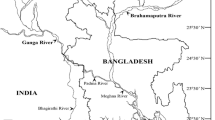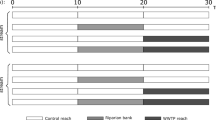Abstract
A mangrove stand of Avicennia marina located at the South Corniche of Jeddah city receives about 100 000 m3 of sewage per day. The sewage has high values of BOD, COD, nutrient concentrations, heavy metals and faecal coliform counts.
The mangrove stand is very small and occupies an area of about 0.45 km2. The trees are stunted with low pneumatophore density. The pneumatophore distribution is restricted to the area of substrate underneath the plant crown covers and they do not look healthy. A high proportion of them was observed to be dead and/or aberrant. These abnormal induced features were attributed to the sewage discharge in the area. The death of pneumatophores decreases the aeration area which apparently affects the respiration rate of the root system, nutrient uptake and plant growth, consequently leading to a retarded growth of the mangroves.
Similar content being viewed by others
References
Böer, B. 1993. Anomalous pneumatophores and adventitious roots of Avicennia marina (Forssk) Vierh. Mangroves two years after the 1991 Gulf War oil spill in Saudi Arabia. Marine Pollution Bulletin 27: 207–211.
Dawes, C.J. 1981. Mangrove communities. pp. 516–538. In: Dawes, C.J. (ed.), Marine Botany. John Wiley & Sons, New York.
Dicks, B. 1986. Oil and the black mangrove, Avicennia marina in the northern Red Sea. Marine Pollution Bulletin 17: 500–503.
Gambrell, R.P., Khalid, R.A. and Patrick, W.H. Jr. 1987. Capacity of a swamp forest to assimilate the TOC loading from a sugar refinery wastewater stream. Journal of Water Pollution Control Federation 59(10): 897–904.
Getter, C.D., Cintron, G., Dicks, B., Lewis, R.R. and Seneca, E.D. 1984. The recovery and restoration of salt marshes and mangrove following an oil spill. pp. 65–113. In: Cairns, J. and Buikema, A. (eds), Restoration of Habitats Impacted by Oil Spills. Butterworth Publishers, Stoneham, MA.
Lenden, O. and Jernelov, A. 1980. The mangrove swamp – an ecosystem in danger. Ambio. 9: 81–88.
Lewis, R.R. 1982. Mangrove forests. pp. 153–171. In: Lewis, R.R. (ed.), Creation and Restoration of Coastal Plant Communities. CRC Press, Inc., Boca Raton, Florida.
Lugo, A.E. and Snedaker, S.C. 1974. The ecology of mangroves. Annual Review of Ecology and Systematics 5: 39–64.
Macnae, W. 1968. A general account of the fauna and flora of mangrove swamps and forests in the Indo-West Pacific Region. Advances in Marine Biology 6: 73–270.
Mandura, A.S., Saifullah, S.M. and Khafaji, A.K. 1987. Mangrove ecosystem of southern Red Sea Coast of Saudi Arabia. Proceedings of the Saudi Biology Society 10: 165–193.
Mandura, A.S., Khafaji, A.K. and Saifullah, S.M. 1988. Ecology of a mangrove stand of a Central Red Sea Coast Area: Ras Hatiba (Saudi Arabia). Proceedings of the Saudi Biological Society 11: 85–112.
Mandura, A.S. and Khafaji, A.K. 1993. Human impact on the mangrove of Khor Farasan Island, Southern Red Sea Coast of Saudi Arabia. Vol. 1, pp. 353–361. In: Leith, H. and Al Masoom, H. (eds), Towards the Rational Use of High Salinity Tolerant Plants. Kluwer Academic Publishers, Dordrecht.
Mandura, A.S. and Khafaji, A.K. 1994. An aerial survey aided ecological remarks on mangrove forests of Farasan Archipelago (Red Sea). pp. 16–24. In: Anaya-Garduño, M., Pascual-Moncayo, M. and Zarate-Zarate, R. (eds.). International Conference on Desert Development (25–30 July 1994), Mexico. Published by International Desert Development Commission.
Mandura, A.S., El-Hassan, A.M., Choudhry, F.A. and Muddarris, M.S. 1994. The effect of sewage pollution of Jeddah city on the South Corniche marine environment including a nearby mangrove stand. A final report submitted to King Abdulaziz University, Project grant No. 164/412, 179 pp.
Mufti, N.M. 1990. Studies of some aspects of Shu'Aybah mangrove ecosystem. M.Sc. thesis, King Abdulaziz University, Saudi Arabia, 177 pp. (in Arabic).
Saifullah, S.M. 1982. Mangrove ecosystem of Pakistan. pp. 69–80. In: The Third Research on Mangroves in Middle East. Publ. No. 137. Tokyo, Japan Cooperation Center for the Middle East.
Saifullah, S.M. and Elahi, E. 1992. Pneumatophores density and size in mangroves of Karachi, Pakistan. Pakistan Journal of Botany 24(1): 5–10.
Saifullah, S.M., Shaukat, S.S. and Shams, S. 1994. Population structure and dispersion pattern in mangrove of Karachi, Pakistan. Aquatic Botany 47: 329–340.
Snedaker, S.C., Jimenez, J.A. and Brown, M.S. 1981. Anomalous roots in Avicennia germinars L. in Florida and Costa Rica. Bulletin of Marine Science 31: 467–470.
Snedaker, C.S. 1984. Mangroves: A summary of knowledge with emphasis on Pakistan, pp. 255–261. In: Haq, B.U. and Milliman, J.D. (eds), Marine Geology and Oceanography of Arabian Sea and Coastal Pakistan. Van Nostrand Reinhold Co., New York.
Turner, R.E. 1977. Intertidal vegetation and commercial yields of penaeid shrimp. Transactions of the American Fisheries Society 106(5): 411–416.
Tomlinson, P.B. 1986. The Botany of Mangroves. Cambridge University Press, Cambridge, New York, Sydney, 413 pp.
Vessey-Fitzgerald, D.F. 1957. Vegetation of the Red Sea coast north of Jeddah, Saudi Arabia. Journal of Ecology 45: 547–569.
Walsh, G.E. 1974. Mangroves: A review. pp. 51–174. In: Reimold, R. and Queen, W. (eds), Ecology of Halophytes. Academic Press, New York.
Wathugala, A.G., Suzuki, T. and Kurihara, Y. 1985. Studies on the removal of phosphorus from the wastewater using sand filtration pot systems with Phragmites australis, Zizania latifolia and Typha latifolia. pp. 332–335. In: Laster, J.N. and Kirk, P.W.W. (eds), Proceedings of the International Conference on Management Strategies for Phosphorus in the Environment, Publisher Selper, London.
Wells, A.G. 1983. Distribution of mangrove species in Australia, Ch. 6. In: Teas, H.J. (ed.), Biology and Ecology of Mangroves. Tasks for vegetation sciences. Dr W. Junk Publishers, The Hague.
Wong, Y.S., Lan. C.Y., Che. S.H., Li, X.R. and Tam, N.F.Y. 1995. Effect of wastewater discharge on nutrient contamination of mangrove soil and plants. Hydrobiologia 295: 243–254.
Zahran, M.A. 1975. Biogeography of mangrove vegetation along the Red Sea coasts, pp. 43–51. In: Walsh, G.E., Snedaker, S.C. and Teas, H. (eds), Proceedings of the International Symposium Management of Mangroves, 8–11 October, 1974. East-West Center, Honolulu, University of Florida, Gainesville, 8446 pp.
Zahran, M.A. 1977. Africa A. Wet formations of the African Red Sea coast. pp. 215–231. In: V.G. Chapman (ed.), Wet Coastal Ecosystem. Elesevier Scientific Publishing Company, Amsterdam.
Zahran, M.A. 1983. Introduction to Plant Ecology and vegetation types of Saudi Arabia. Faculty of Meteorology and Environmental Studies Publicaltions, King Abdulaziz University, Jeddah, Saudi Arabia, 142 pp.
Author information
Authors and Affiliations
Rights and permissions
About this article
Cite this article
Mandura, A. A mangrove stand under sewage pollution stress: Red Sea. Mangroves and Salt Marshes 1, 255–262 (1997). https://doi.org/10.1023/A:1009927605517
Issue Date:
DOI: https://doi.org/10.1023/A:1009927605517




